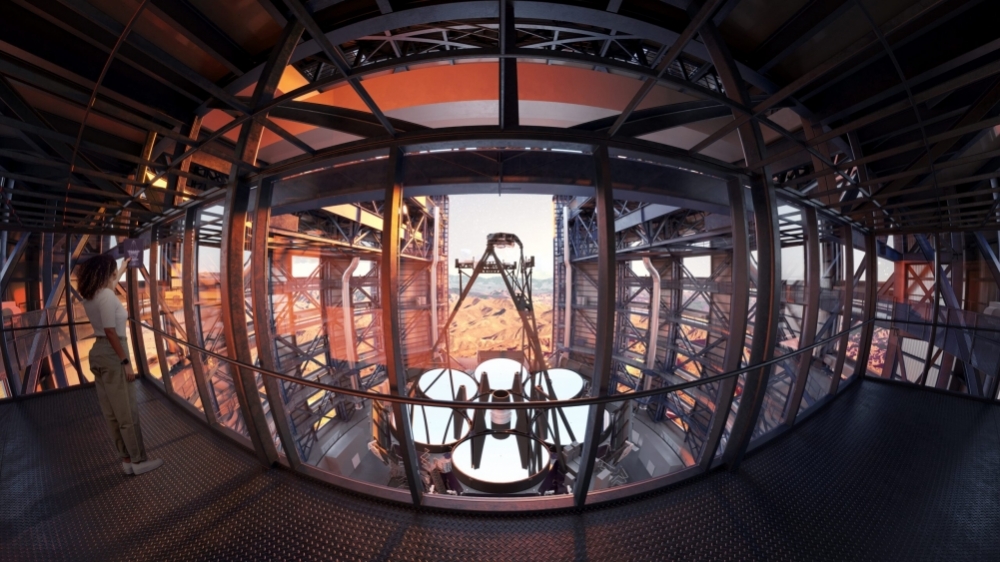

Funding from six institutions, including the São Paulo Research Foundation (FAPESP), will be used to accelerate completion of the GMT’s seven primary mirrors and scientific instrumentation (photo: GMT)
Funding from six institutions, including the São Paulo Research Foundation (FAPESP), will be used to accelerate completion of the GMT’s seven primary mirrors and scientific instrumentation.
Funding from six institutions, including the São Paulo Research Foundation (FAPESP), will be used to accelerate completion of the GMT’s seven primary mirrors and scientific instrumentation.

Funding from six institutions, including the São Paulo Research Foundation (FAPESP), will be used to accelerate completion of the GMT’s seven primary mirrors and scientific instrumentation (photo: GMT)
Elton Alisson | Agência FAPESP – The Giant Magellan Telescope (GMT) will receive new investment worth USD 205 million from the international consortium of institutions that are leading the project. The aim is to accelerate completion of the telescope.
According to press releases issued by the GMT’s lead institutions, the investment represents one of the largest funding rounds to date. The capital will be injected by the São Paulo Research Foundation (FAPESP) in Brazil, and five institutions in the United States: the Carnegie Institution for Science, the University of Arizona, the University of Chicago, the University of Texas at Austin, and Harvard University. All six are founding partners in the initiative to construct the most-powerful telescope ever engineered.
The investment will be used to manufacture the telescope’s 12-story steel structure, to continue progress on the seven primary mirrors, and to build one of the world’s most advanced scientific spectrographs. A spectrograph is a scientific instrument that breaks the light from a single material into its component colors so that scientists can analyze this spectrum and discover properties of the material.
“The funding is truly a collaborative effort from our founders. It will result in the fabrication of the world’s largest mirrors, the giant telescope mount that holds and aligns them, and a science instrument that will allow us to study the chemical evolution of stars and planets like never before,” said GMT President Robert Shelton.
FAPESP will contribute USD 45 million via a special project led by Laerte Sodré Junior, a professor at the University of São Paulo's Institute of Astronomy, Geophysics and Atmospheric Sciences (IAG-USP).
This investment will ensure that Brazilian researchers will be able to use a corresponding percentage of the GMT’s operating time for their own observations and studies.
“We’re achieving outstanding success in the development of instrumentation for the GMT. The project’s systems engineering team is currently under our responsibility,” Sodré Junior said.
Next-generation telescopes
The GMT is under construction at the Las Campanas Observatory in Chile's Atacama Desert, and will be part of a new generation of ground-based extremely large telescopes capable of unprecedented clarity and sensitivity in observing astrophysical phenomena such as the origins of the chemical elements and the formation of the first stars and galaxies.
The GMT's seven mirrors, each with a diameter of 8.4 m, will form an effective aperture of 25.4 m. It will be up to 200 times more powerful than existing research telescopes. It will have ten times the light-collecting area and four times the spatial resolution of the James Webb Space Telescope (JWST), which was launched at the end of 2021. NASA began releasing images from the JWST in July 2022.
The GMT's unprecedented angular resolution, combined with revolutionary spectrographs and high-contrast cameras, will work in direct synergy with the JWST to empower new scientific discoveries. It will be the next step in studying the physics and chemistry of the faintest light sources in space that the JWST will identify. This includes searching the atmospheres of potentially habitable planets for life, studying the first galaxies that formed in the universe, and finding clues that will unravel the mysteries of dark matter, dark energy, black holes, and the formation of the universe itself.
“We’re working with some of the brightest engineers and scientists at the leading research institutions around the globe,” said Walter Massey, Chair of the GMT’s Board, former Director of the US National Science Foundation (NSF), and former Chair of Bank of America. “The recent contributions from our investing partners in the GMT are collectively pushing the boundaries of astronomy, making the future a reality, and allowing us to answer some key scientific questions.”
Construction of the GMT has achieved significant progress over the last few years. Six of seven primary mirror segments have been cast in Tucson, Arizona. The third primary mirror segment has completed its two-year polishing phase and is undergoing final testing. Construction of a 3,700 square meter facility in Rockford, Illinois, to manufacture the telescope structure is complete. Production of the first adaptive secondary mirror is well under way in France and Italy, and the site in Chile is primed for the next stage of construction and pouring of the foundation.
According to the press releases, this latest investment round positions the GMT to be one of the first in a new generation of extremely large telescopes. The telescope’s first use to take astronomical images (first light) is expected by the end of the decade.
“Six like-minded founders of the GMT worked together to close the financial gap between the resources we have attracted to build the telescope and what is required to complete it,” said Eric Isaacs, President of Carnegie Institution for Science. “This investment will bring the telescope closer to first light and provide the world with transformational knowledge of our Universe. Carnegie is proud to have kickstarted the funding effort and to have worked closely with our peers.”
Republish
The Agency FAPESP licenses news via Creative Commons (CC-BY-NC-ND) so that they can be republished free of charge and in a simple way by other digital or printed vehicles. Agência FAPESP must be credited as the source of the content being republished and the name of the reporter (if any) must be attributed. Using the HMTL button below allows compliance with these rules, detailed in Digital Republishing Policy FAPESP.





